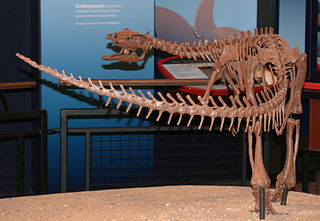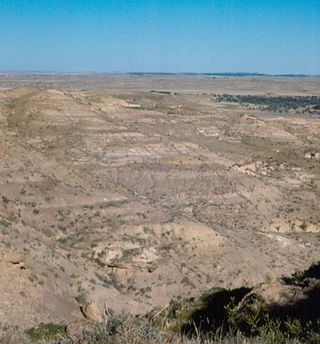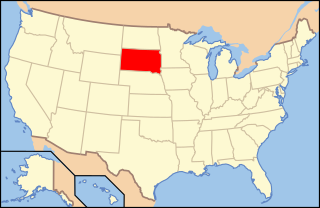
Archelon is an extinct marine turtle from the Late Cretaceous, and is the largest turtle ever to have been documented, with the biggest specimen measuring 4.6 m (15 ft) from head to tail and 2.2–3.2 t in body mass. It is known only from the Pierre Shale and has one species, A. ischyros. In the past, the genus also contained A. marshii and A. copei, though these have been reassigned to Protostega and Kansastega, respectively. The genus was named in 1895 by American paleontologist George Reber Wieland based on a skeleton from South Dakota, who placed it into the extinct family Protostegidae. The leatherback sea turtle was once thought to be its closest living relative, but now, Protostegidae is thought to be a completely separate lineage from any living sea turtle.

Thescelosaurus was a genus of small neornithischian dinosaur that appeared at the very end of the Late Cretaceous period in North America. It was a member of the last dinosaurian fauna before the Cretaceous–Paleogene extinction event around 66 million years ago. The preservation and completeness of many of its specimens indicate that it may have preferred to live near streams.

The Hell Creek Formation is an intensively studied division of mostly Upper Cretaceous and some lower Paleocene rocks in North America, named for exposures studied along Hell Creek, near Jordan, Montana. The formation stretches over portions of Montana, North Dakota, South Dakota, and Wyoming. In Montana, the Hell Creek Formation overlies the Fox Hills Formation. The site of Pompeys Pillar National Monument is a small isolated section of the Hell Creek Formation. In 1966, the Hell Creek Fossil Area was designated as a National Natural Landmark by the National Park Service.

The Lance (Creek) Formation is a division of Late Cretaceous rocks in the western United States. Named after Lance Creek, Wyoming, the microvertebrate fossils and dinosaurs represent important components of the latest Mesozoic vertebrate faunas. The Lance Formation is Late Maastrichtian in age, and shares much fauna with the Hell Creek Formation of Montana and North Dakota, the Frenchman Formation of southwest Saskatchewan, and the lower part of the Scollard Formation of Alberta.

Protosphyraena is a fossil genus of swordfish-like marine fish, that thrived worldwide during the Upper Cretaceous Period (Coniacian-Maastrichtian). Though fossil remains of this taxon have been found in both Europe and Asia, it is perhaps best known from the Smoky Hill Member of the Niobrara Chalk Formation of Kansas. Protosphyraena was a large fish, averaging 2–3 metres in length. Protosphyraena shared the Cretaceous oceans with aquatic reptiles, such as mosasaurs and plesiosaurs, as well as with many other species of extinct predatory fish. The name Protosphyraena is a combination of the Greek word protos ("early") plus Sphyraena, the genus name for barracuda, as paleontologists initially mistook Protosphyraena for an ancestral barracuda. Recent research shows that the genus Protosphyraena is not at all related to the true swordfish-family Xiphiidae, but belongs to the extinct family Pachycormidae.

Polycotylidae is a family of plesiosaurs from the Cretaceous, a sister group to Leptocleididae. Polycotylids first appeared during the Albian stage of the Early Cretaceous, before becoming abundant and widespread during the early Late Cretaceous. Several species survived into the final stage of the Cretaceous, the Maastrichtian.

The Dakota is a sedimentary geologic unit name of formation and group rank in Midwestern North America. The Dakota units are generally composed of sandstones, mudstones, clays, and shales deposited in the Mid-Cretaceous opening of the Western Interior Seaway. The usage of the name Dakota for this particular Albian-Cenomanian strata is exceptionally widespread; from British Columbia and Alberta to Montana and Wisconsin to Colorado and Kansas to Utah and Arizona. It is famous for producing massive colorful rock formations in the Rocky Mountains and the Great Plains of the United States, and for preserving both dinosaur footprints and early deciduous tree leaves.

Dakotadon is a genus of iguanodont dinosaur from the Barremian-age Lower Cretaceous Lakota Formation of South Dakota, USA, known from a partial skull. It was first described in 1989 as Iguanodon lakotaensis, by David B. Weishampel and Philip R. Bjork. Its assignment has been controversial. Some researchers suggest that "I." lakotaensis was more basal than I. bernissartensis, and related to Theiophytalia, but David Norman has suggested that it was a synonym of I. bernissartensis. Gregory S. Paul, working on a revision of iguanodont species, gave "I." lakotaensis its own genus (Dakotadon) in 2008. He measured its length at 6 metres (20 ft) and body mass at 1 metric ton.
Stratodus is a genus of giant prehistoric aulopiform fish found in Cretaceous-aged marine strata of Kansas, Alabama, Morocco, Israel, and Niger, South Dakota, Jordan. It has also been found in the Tamaguélelt Formation of Mali, dating to the Lower Eocene, indicating that Stratodus survived the Cretaceous-Paleogene extinction event. This sleek fish has an upper jaw filled with multiple rows of tiny teeth and was the largest aulopiform, reaching 5 meters in length.

The Pierre Shale is a geologic formation or series in the Upper Cretaceous which occurs east of the Rocky Mountains in the Great Plains, from Pembina Valley in Canada to New Mexico.

The Niobrara Formation, also called the Niobrara Chalk, is a geologic formation in North America that was deposited between 87 and 82 million years ago during the Coniacian, Santonian, and Campanian stages of the Late Cretaceous. It is composed of two structural units, the Smoky Hill Chalk Member overlying the Fort Hays Limestone Member. The chalk formed from the accumulation of coccoliths from microorganisms living in what was once the Western Interior Seaway, an inland sea that divided the continent of North America during much of the Cretaceous. It underlies much of the Great Plains of the US and Canada. Evidence of vertebrate life is common throughout the formation and includes specimens of plesiosaurs, mosasaurs, pterosaurs, and several primitive aquatic birds. The type locality for the Niobrara Chalk is the Niobrara River in Knox County in northeastern Nebraska. The formation gives its name to the Niobrara cycle of the Western Interior Seaway.

Pahasapasaurus is a genus of plesiosaur. It was an early polycotylid plesiosaur from the Cenomanian of South Dakota, USA. Distinctive features of the taxon include elongate epipodial bones and the nature of the palate bones. The type species is P. haasi.
Palaeopsephurus is an extinct genus of paddlefish (Polyodontidae). At present the genus contains the single species Palaeopsephurus wilsoni. The genus is known from the Late Cretaceous (Maastrichtian) aged Hell Creek Formation of Montana.
Anomoeodus is an extinct genus of prehistoric ray-finned fish belonging to the family Pycnodontidae. This genus lived during the Late Cretaceous period, ranging from the Albian to Maastrichtian ages, and had a wide geographic distribution, with fossils found in France, Belgium, the Netherlands, Spain, Egypt, Uzbekistan, and the United States. The first fossils of Anomoeodus were described by Louis Agassiz in 1835.
Cylindracanthus is an extinct genus of Cretaceous to Eocene aged ray-finned fish. It is almost exclusively known from bony rostrum fragments as well as some associated teeth, with the rest of the skeleton being cartilaginous. While originally considered to be closely related to billfish, the structure of its rostrum is dissimilar, and is unlikely to be closely related, some later studies suggested closer affinities to the Acipenseriformes. However, this was later rejected due to the lack of osteocytes in histologically examined specimens, which resembles the condition of derived teleosts. A close relation to Blochius has been suggested.

Tselfatia is an extinct genus of Cretaceous bony fish. Originally described from Djebl Tselfat in Morocco, it has since been discovered at sites in several other countries. The type species, Tselfatia formosa, was named and described in 1944 by French paleontologist Camille Arambourg. A second species, T. dalmatica, was named in 1980 from the Dalmatian Coast of Yugoslavia.
Brodavis is a genus of freshwater hesperornithiform birds known from the Late Cretaceous of North America and Asia. It was first described and named by Larry D. Martin, Evgeny N. Kurochkin and Tim T. Tokaryk in 2012 and assigned to a new monogeneric family, Brodavidae. Four species were described and assigned to Brodavis.

Paleontology in South Dakota refers to paleontological research occurring within or conducted by people from the U.S. state of South Dakota. South Dakota is an excellent source of fossils as finds have been widespread throughout the state. During the early Paleozoic era South Dakota was submerged by a shallow sea that would come to be home to creatures like brachiopods, cephalopods, corals, and ostracoderms. Local sea levels rose and fall during the Carboniferous and the sea left completely during the Permian. During the Triassic, the state became a coastal plain, but by the Jurassic it was under a sea where ammonites lived. Cretaceous South Dakota was also covered by a sea that was home to mosasaurs. The sea remained in place after the start of the Cenozoic before giving way to a terrestrial mammal fauna including the camel Poebrotherium, three-toed horses, rhinoceroses, saber-toothed cat, and titanotheres. During the Ice Age glaciers entered the state, which was home to mammoths and mastodons. Local Native Americans interpreted fossils as the remains of the water monster Unktehi and used bits of Baculites shells in magic rituals to summon buffalo herds. Local fossils came to the attention of formally trained scientists with the Lewis and Clark Expedition. The Cretaceous horned dinosaur Triceratops horridus is the South Dakota state fossil.

Acheroraptor is an extinct genus of dromaeosaurid theropod dinosaur known from the latest Maastrichtian Hell Creek Formation of Montana, United States. It contains a single species, Acheroraptor temertyorum. A. temertyorum is one of the two geologically youngest known species of dromaeosaurids, the other being Dakotaraptor, which is also known from Hell Creek. A basal cousin of Velociraptor, Acheroraptor is known from upper and lower jaw material.

Tselfatiiformes is an extinct order of bony fishes from the infraclass Teleostei. The order represents the most important radiation of marine teleosts during the Cretaceous period. Fossils of tselfatiiforms are known from Europe, North America, central and northern South America, the Middle East and North Africa.














